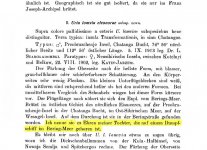James Jobling
Well-known member

Work continues in bringing HBWAlive Key to Scientific Names in Ornithology up to date. A substantial portion of the scientific names still unseen by me are contained in German publications not yet found on BHL or still to be viewed at Tring or South Kensington. Some of the older journals are listed below; any input, suggested etymologies, copies of the relevant papers, etc., would be very much appreciated.
● Allgemeine Deutsche Naturhistorische Zeitung. Dresden & Leipzig.
1857 Strix kirchhoffii A. E. Brehm, p. 440
●Jahresberichte über die Wirksamkeit und den Zustand der Naturforschenden Gesellschaft in Emden.
1851 Turdus mure Kreling, p. 22
●Mitteilungen aus dem Zoologischen Museum in Berlin
1931 Pinicola enucleator stschur Portenko, 17, p. 422
1931 Xanthotis subfrenata kingwalip Mayr, 17, p. 663
1937 Uria lomvia eleonorae Portenko, 22, p. 227
1940 Passer rutilans lisarum Stresemann, 24, p. 72
●Ornithologische Monatsberichte. Berlin.
1908 Riparia ducis Reichenow, 16, p. 81
1932 Edolisoma tenuirostre edithae Stresemann, 40, p. 109
1933 Tribura tacsanowskia chui Yen, 41, p. 15
1933 Pternistis afer tornowi Meise, 41, pp. 141+
1934 Serinus mozambicus gertrudis Grote, 42, p. 87
1934 Pycnonotus tricolor naumanni Meise, 42, p. 116
●Verhandlungen der Ornithologischen Gesellschaft in Bayern. München.
1927 Chloroceryle americana mathewsii Laubmann, 17, p. 126
● Allgemeine Deutsche Naturhistorische Zeitung. Dresden & Leipzig.
1857 Strix kirchhoffii A. E. Brehm, p. 440
●Jahresberichte über die Wirksamkeit und den Zustand der Naturforschenden Gesellschaft in Emden.
1851 Turdus mure Kreling, p. 22
●Mitteilungen aus dem Zoologischen Museum in Berlin
1931 Pinicola enucleator stschur Portenko, 17, p. 422
1931 Xanthotis subfrenata kingwalip Mayr, 17, p. 663
1937 Uria lomvia eleonorae Portenko, 22, p. 227
1940 Passer rutilans lisarum Stresemann, 24, p. 72
●Ornithologische Monatsberichte. Berlin.
1908 Riparia ducis Reichenow, 16, p. 81
1932 Edolisoma tenuirostre edithae Stresemann, 40, p. 109
1933 Tribura tacsanowskia chui Yen, 41, p. 15
1933 Pternistis afer tornowi Meise, 41, pp. 141+
1934 Serinus mozambicus gertrudis Grote, 42, p. 87
1934 Pycnonotus tricolor naumanni Meise, 42, p. 116
●Verhandlungen der Ornithologischen Gesellschaft in Bayern. München.
1927 Chloroceryle americana mathewsii Laubmann, 17, p. 126





